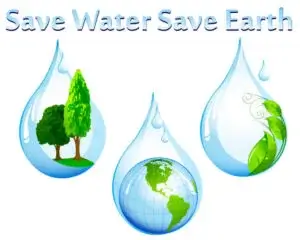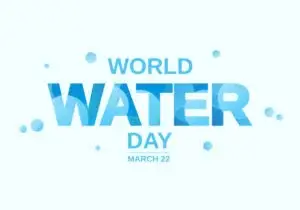World Water Day is an annual observance day by the United Nations that not only highlight the importance of fresh water but also a combined effort to eradicate the challenges of getting fresh/pure water and sanitation for everyone.
World Water Day

There are 17 Sustainable Development Goals set by the United Nations, of which fresh water and sanitation to all by 2030 stays at number 6 as per priority.
The theme of each year focuses on topics relevant to clean water, sanitation and hygiene, which is in line with the targets of Sustainable Development Goal 6. The UN World Water Development Report (WWDR) is released each year around World Water Day.
World Water Day is an international observance day. The intention is to inspire people around the world to learn more about water-related issues and to take action to make a difference. In 2020, due to the COVID-19 pandemic, there was an additional focus on hand washing and hygiene.
Billions of people will face water shortages in the coming decades as climate change, population growth and changing agricultural practices strain water supplies like never before, the UN has warned.
Water consumption historically has increased about 1 per cent annually and that trend will continue, with the world projected to use about 25 per cent more water in 2050 than it does today, the UN’s annual World Water Development report stated on Wednesday.
The report said water scarcity was becoming endemic due to overconsumption and pollution, with global warming expected to increase seasonal shortages.
Cities will experience the greatest strain: In 2016, about 933 million people in cities faced water scarcity. By 2050, that number is forecast to hit 2.4 billion, with India the most affected, the report found.
“Urban water demand is projected to increase by 80 per cent between now and 2050, and [the] global urban population facing water scarcity is projected to double during the same time,”
According to UN, at present, one in four people (two billion people worldwide) – lack safe drinking water. Around 1.4 million people die annually and 74 million will have their lives shortened by diseases related to poor water, sanitation and hygiene. As per the estimates by OECD, global water demand (in water withdrawals) would increase by 55% by 2050.
Various organizations, NGOs and individuals celebrate the World Water day in their own way to conserve water in a bid to tackle water crisis.
The UN is also kickstarting the UN 2023 Water Conference- the first event of its kind for nearly 50 years to unite the world around water from March 22-24 in New York, United States.
United Nations Sustainable Development Goals
1 – No poverty
2 – Zero Hunger
3 – Good health and wellbeing
4 – Quality education
5 – Gender equality
6 – Clean water and sanitation
7 – Affordable and clean energy
8 – Decent work and economic growth
9 – Industry, Innovation and infrastructure
10 – Reduced inequalities
11 – Sustainable cities and communities
12 – Responsible consumptions and production
13 – Climate action
14 – Life below water
15 – Life on land
16 – Peace, Justice and strong institutions
17 – Partnerships for the goals
World Water Day Annual Themes
The theme for World Water Day 2023 is “Accelerating the change to solve the water and sanitation crisis.” The theme emphasises the necessity to take more aggressive steps to address the global water crisis and fulfil international commitments on water-related sustainable development goals.
| World Water Day Themes | |
| 1994 | Caring for our Water Resources is Everybody’s Business |
| 1995 | Women and Water |
| 1996 | Water for Thirsty Cities |
| 1997 | The World’s Water: Is there enough? |
| 1998 | Groundwater– The Invisible Resource |
| 1999 | Everyone Lives Downstream |
| 2000 | Water for the 21st century |
| 2001 | Water for Health |
| 2002 | Water for Development. |
| 2003 | Water for Future |
| 2004 | Water and Disasters. |
| 2005 | Water for Life Decade 2005–2015. |
| 2006 | Water and Culture |
| 2007 | Coping With Water Scarcity |
| 2008 | Sanitation |
| 2009 | Trans Waters |
| 2010 | Clean Water for a Healthy World |
| 2011 | Water for cities: responding to the urban challenge. |
| 2012 | Water and Food Security |
| 2013 | International Year of Cooperation |
| 2014 | Water and Energy |
| 2015 | Water and Sustainable Development |
| 2016 | Better Water, Better Jobs |
| 2017 | Why Waste Water? |
| 2018 | Nature for Water |
| 2019 | Leaving No One Behind |
| 2020 | Water and Climate Change |
| 2021 | Valuing Water |
| 2022 | Groundwater, Making the Invisible Visible |
Innovative ways for sustainable water management
World Water Day, Tips for better water management
| Tips for better water management |
| Take shorter showers to reduce water consumption. |
| Check your water bill to see how much water you are using. • Check all faucets, pipes, and toilets for leaks. |
| Use mug instead of running the tap while brushing teeth or shaving. |
| Use a toilet flush which consumes less water. |
| Water your plants early in the morning or late in the evening to reduce water loss due to evaporation. |
| While watering plants, use watering-can instead of a running hose. |
| Use water efficient sprinkler and drip irrigation for your garden. |
| Promote drip irrigation and other water conservation methods in agriculture. Practice rainwater harvesting. RWAs should adopt this in every public park of their locality. |
| Make roof top rain water harvesting and recharging wells/ tanks mandatory. |
| Utilize kitchen waste water for home gardening. |
| Establish community nursery by using waste water and distribute saplings in the neighbourhood. |
| Wash utensils using collected water in a bucket instead of washing directly under the running tap. |
| Instead of washing mop the floor |
| Select village level volunteers to check whether all the public taps and pipes are leak free. |
| Promote Eco-san toilets : a closed water – less system |
| Skip rinsing dishes before using your dishwasher and save water in each load. |
| Don’t allow water overflow from the overhead tank. |
| Don’t wash the clothes and kitchen utensils in the water bodies. |
| Don’t throw waste in water bodies. |
| Run your dishwasher, washing machine, and dryer only when you have full loads. |
| Dry clothes in sunlight |
| Make water saving devices in taps mandatory. |
| Use rejects of your RO |
| Make percolation pits appropriately in backyards and parking . |
| Avoid concrete pavements inside the compounds. Keep of 5-10 percent of your residence ground unpaved for water percolation. |
| Use less fertiliser on your lawn – better use compost than chemical fertilisers. |
| Set your sprinkler to keep the water on the lawn. |
| Mulch around your landscaped area. A three-inch layer of mulch holds moisture and prevents evaporation, and conserves soil moisture thus reducing the need to water. |
| Sweep your driveway and sidewalk instead of cleaning with water and PLANT TREES |
Message from Audrey Azoulay, UNESCO Director-General
“Water is our common future and we need to act together to share it equitably and manage it sustainably. As the world convenes for the first major United Nations conference on water in the last half century, we have a responsibility to plot a collective course ensuring water and sanitation for all.”
As per the UN World Water Development Report 2023 released today on 22nd March’2023, At current rates of progress, Sustainable Development Goal (SDG) 6 – water and sanitation for all – will not be achieved by 2030. Accelerated implementation is needed, which depends on the capacity of the world’s organizations and institutions to come together in partnerships and cooperation to rapidly speed up progress.
The UN WWDR ( United Nations World Water Day Report ) will review how the water and sanitation community can cooperate more effectively within itself and with other sectors and realms of decision-making where water is critical for progress, such as health, education, climate change and gender equality.
To read more articles from the General awareness section, please click here.
